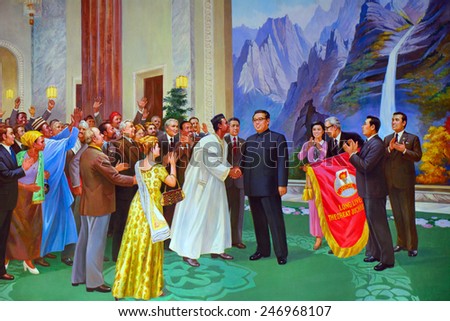A Strange Cold War Partnership: North Korea and Guyana
What did North Korea and Guyana want of each other during the height of the Cold War?

NORTH KOREA, SARIWON - JUNE 13: Kim Il-sung and African leaders on a painting at June 13, 2014 in Sariwon, Kim Il-sung was the first president of the DPRK.
Cold War politics made for strange bedfellows. Albania and the People’s Republic of China became fast friends, because of a shared aversion to the Soviet Union. The United States developed a cordial relationship with Romania, despite the brutality of the Ceaușescu government. Both China and the United States became far too defensive of the Khmer Rouge regime in Cambodia, in order to balance against the power of Vietnam.
Among these, the strangest of the bedfellows may have been the Democratic People’s Republic of Korea and the small South American country Guyana. A recent article by Moe Taylor (reviewed by Suzy Kim) sheds light on this odd relationship. Guyana’s leader, Forbes Burnham, was inspired by the apparent discipline and devotion of North Korea’s workforce, and of its gymnastics performance teams.
From its independence in 1966, Guyana had sought to solidify its legitimacy by playing an outsized role on the international stage. This began with membership in the Non-Aligned Movement and continued under Burnham with a hard shift left, as Guyana sought to establish credentials within the socialist bloc. The proximity of the United States only served to make this turn more appealing; Guyana could demonstrate its independence by thumbing its nose in the face of the regional superpower.
The relationship with North Korea emerged as part of this project. Pyongyang sought to demonstrate its own legitimacy, generosity, and power by developing relationships with a variety of countries in the Third World. Guyana appealed in large part because of its proximity to the United States. In addition to general statements of ideological affinity, North Korean support for Guyana also ran to the practical; the DPRK supplied manufactured goods and educational materials to Guyana in exchange for raw materials.
Guyana was also, notably, the site of a horrific mass suicide led by cult leader Jim Jones. The People’s Temple had selected Guyana as a suitable site for a settlement because of the country’s leftist policies and distance from the United States. In 1978, as the relationship between North Korea and Guyana began to bloom, 909 Americans either committed suicide or were murdered in Jonestown, the settlement that the People’s Temple had established in 1974. Prior to the suicide, the People’s Temple had explored the possibility of developing a relationship with North Korea, as well as with Cuba and the Soviet Union.
The relationship between North Korea and Guyana largely ended with Burnham’s death in 1985. Burnham’s efforts failed to catalyze Guyanese society, which differed from North Korean in significant ways; Guyana began at a much lower level of development than North Korea and had a variety of ethnic cleavages that did not exist in the DPRK. Burnham could not establish a police state on par with Kim Il-sung, although he did periodically crack down on domestic opposition. The death of Burnham, and the end of the Soviet Union not long after, rendered the relationship with North Korea altogether pointless. The latter also pushed North Korea into self-isolation, a policy that continues today.
